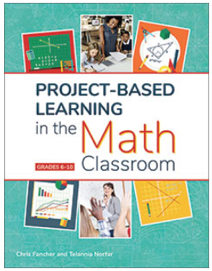
As I approach the math teachers in a PBL 101 workshop, I can see the look on their faces: a mixture of gladness that the facilitator is a math teacher and slight anxiety about how they will do this in their classroom. As soon as I take a seat, the teachers begin their all-too-familiar series of comments and questions. “I just don’t see how you can make a project out of solving linear equations,” says an Algebra I teacher. “I teach Calculus. I don’t have two weeks to give to one learning target,” says a woman with a genuinely perplexed face. “I teach Geometry. I get how to make a project on area or volume but how do you do one about transformations?” said another. The final teacher in the group, who had been looking at papers for the last few rounds of questions, moves his papers aside and says, “Do you do projects every day?”
Chris Fancher and I heard these questions so much in workshops, we decided to write a book to help math teachers. In Project Based Learning in the Math Classroom, we explain a process for creating a PBL unit, inquiry strategies, example projects and more. As in the 101 workshop, most teachers want to know where to get started. Here are two strategies used to generate ideas.

Start with an Internet Search
The internet is a great place to get ideas. A Google search using the terms “math project middle school,” for example, yields more than 8 million hits. In addition to open searching, there are websites such as MashUp Math, We Are Teachers, PBLWorks, Edutopia, and, of course, Pinterest. Project ideas are everywhere online. The key is to know they just help you get an idea, but they are not actually true Gold Standard PBL projects. If you look at the details, they are set up as ways for students to demonstrate what they have already learned, not as the vehicle for learning the content.
There is no problem with seeking out these “projects” as idea generators. The problem arises from trying to execute these projects as they are written. Instead, you have to break them down into the standards you want to cover and add the Essential Project Design Elements identified by PBLWorks.
Start with the (Power) Standards
Another common way to create projects is to start with the standards. This is especially true for higher-level classes in which algebraic and geometric ideas are kept separate. If you choose to start with standards, you must know that not all standards lend themselves to a PBL unit. For example, one of the standards in the CCSS for sixth grade is “Write expressions that record operations with numbers and with letters standing for numbers. For example, express the calculation ‘Subtract y from 5’ as 5 - y.”This standard is not worthy of a PBL unit because it doesn’t require much inquiry.
When creating a PBL unit, it is helpful to use power standards, those that are the most essential for student success at every grade level. These are standards that take up more time in the curriculum. Many districts, as well as states, have identified the power standards for any grade level or subject. Sometimes these standards are called essential standards. Another way to identify these standards is by the amount of time your district allocates to specific standards. Power standards are the ones given the most amount of time.
If your district and state have not identified power standards, identifying them is a really simple process that should be done with colleagues of the same grade level or subject. It is a great process to do, even if your district has identified them. Larry Ainsworth provides a simple set of criteria for identifying the standards: endurance, leverage, and readiness for the next level of learning and for a state test. The criteria can be thought of as a simple question: “Which standards will students still use as adults (endurance) and use in other classes (leverage), are needed for the next grade level (readiness), or will be a major portion of an upcoming state test?” Once you select the standards based upon this question, cluster them together as appropriate.
In addition to identifying power standards, highlight the standards that are written with wording or examples that helps you know it is worthy of a project. For example, in the Common Core Standards for high school algebra, Seeing Structure in Expressions part 4 says, “Derive the formula for the sum of a finite geometric series (when the common ratio is not 1), and use the formula to solve problems. For example, calculate mortgage payments.” This standard has an example that is related to an authentic situation. In earlier grade levels, the standards use the words “real-world problems” rather than give a specific example.
Here are some key things to remember as you get ideas for math projects:
- Searching is only the beginning. You have to adapt what you find to fit the Gold Standard PBL model.
- Don’t forget about your students. Make sure it is something that would interest them or that you can get them interested in.
- Not all standards are worthy of projects but all standards can have elements of PBL. Remember the dimmer switch approach.
- Projects are typically about more than one standard. This moves the emphasis from just skills to concepts and skills.

